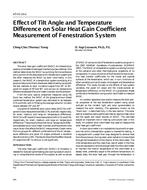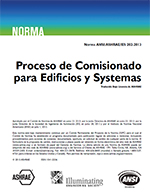Description
The solar heat gain coefficient (SHGC) of a fenestration system can be determined experimentally by two methods. One method determines the SHGC by summing the transmittance and a portion of the absorptance of a fenestration system and the other measures the SHGC by solar calorimetry. In this research, the SHGC of a fenestration system consisting of a glass window and a black shade was determined by using both the test methods at solar incidence angles from 20° to 30°, panel tilt angles of 45°and 90°, and various air temperature differences between the calorimeter chamber and the ambient. From the solar optical properties measured using the black box method, the SHGC of the glass/aluminum shade combined fenestration system was estimated to be between 0.75 and 0.83, with 0.79 being the average value for incident angles between 20° and 30°. Using the UF/ASHRAE solar calorimeter, SHGC for a 45° panel tilt was measured to be 0.80, 0.76, and 0.60, respectively, for small, medium, and large air temperature differences. SHGC for a 90° panel tilt was measured as 0.83, 0.74, and 0.59, respectively, for small, medium, and large air temperature differences. These results show that the air temperature differ-ence between solar calorimeter chamber and the ambient is the major factor that affects the SHGC measurement. Experiments from six groups for different combinations of the air temper-ature difference and panel tilt angles produced a standard deviation of only 2.8%. The results show that the effect of panel tilt angle from 45° to vertical is not significant.
Units: SI
Citation: Symposium Papers, Atlanta, GA, 2001
Product Details
- Published:
- 2001
- Number of Pages:
- 7
- File Size:
- 1 file , 230 KB
- Product Code(s):
- D-7175




